Biochar Promotes Phosphorus Solubilization by Reconstructing Soil Organic Acid and Microorganism Networks
Abstract
1. Introduction
2. Material and Methods
2.1. Experimental Material
2.2. Experimental Design
2.3. Methods of Testing
2.3.1. Measurement of Chemical Indicators
2.3.2. Microbial Amplicon Sequencing
2.3.3. Measurement of Organic Acids
2.4. Statistical Analysis
3. Results
3.1. Effect of Biochar on Soil P Fractions of Different Crops
3.2. Effect of Biochar on Soil Organic Acid Fractions of Different Crops
3.3. Effect of Biochar on the Soil Microbial Community Structure of Different Crops
3.4. Relationship Between Microorganisms and P Fractions After the Addition of Biochar
3.5. The Potential Response Mechanisms Between Organic Acids, Microbial Communities, and P Fractions
3.6. Verifying the Promoting Effect of Core Organic Acids on Soil P Availability
4. Discussion
4.1. Effect of Biochar on Soil P Availability
4.2. Reconstruction of Organic Acid and Microbial Networks
4.3. Drivers of P Solubilization by Biochar
5. Conclusions
Supplementary Materials
Author Contributions
Funding
Data Availability Statement
Conflicts of Interest
References
- Xue, Y.; Zhuang, Q.; Zhu, S.; Xiao, B.; Liang, C.; Liao, H.; Tian, J. Genome wide transcriptome analysis reveals complex regulatory mechanisms underlying phosphate homeostasis in soybean nodules. Int. J. Mol. Sci. 2018, 19, 2924. [Google Scholar] [CrossRef] [PubMed]
- Basinski, J.J.; Bone, S.E.; Klein, A.R.; Thongsomboon, W.; Mitchell, V.; Shukle, J.T.; Druschel, G.K.; Thompson, A.; Aristilde, L. Unraveling iron oxides as abiotic catalysts of organic phosphorus recycling in soil and sediment matrices. Nat. Commun. 2024, 15, 5930. [Google Scholar] [CrossRef]
- Fiuza, D.A.F.; Vitorino, L.C.; Souchie, E.L.; Neto, M.R.; Bessa, L.A.; Silva, C.F.d.; Trombela, N.T. Effect of Rhizobacteria Inoculation via Soil and Seeds on Glycine max L. Plants Grown on Soils with Different Cropping History. Microorganisms 2022, 10, 691. [Google Scholar] [CrossRef] [PubMed]
- Abdelmigid, H.M.; Morsi, M.M.; Hussien, N.A.; Alyamani, A.A.; Alhuthal, N.A.; Albukhaty, S. Green synthesis of phosphorous-containing hydroxyapatite nanoparticles (nHAP) as a novel nano-fertilizer: Preliminary assessment on pomegranate (Punica granatum L.). Nanomaterials 2022, 12, 1527. [Google Scholar] [CrossRef]
- McLaren, T.I.; Smernik, R.J.; McLaughlin, M.J.; McBeath, T.M.; Kirby, J.K.; Simpson, R.J.; Guppy, C.N.; Doolette, A.L.; Richardson, A.E. Complex forms of soil organic phosphorus—A major component of soil phosphorus. Environ. Sci. Technol. 2015, 49, 13238–13245. [Google Scholar] [CrossRef]
- Weng, L.; Vega, F.A.; Van Riemsdijk, W.H. Competitive and synergistic effects in pH dependent phosphate adsorption in soils: LCD modeling. Environ. Sci. Technol. 2011, 45, 8420–8428. [Google Scholar] [CrossRef]
- Andersson, K.O.; Tighe, M.K.; Guppy, C.N.; Milham, P.J.; McLaren, T.I.; Schefe, C.R.; Lombi, E. XANES demonstrates the release of calcium phosphates from alkaline vertisols to moderately acidified solution. Environ. Sci. Technol. 2016, 50, 4229–4237. [Google Scholar] [CrossRef]
- Shulse, C.N.; Chovatia, M.; Agosto, C.; Wang, G.; Hamilton, M.; Deutsch, S.; Yoshikuni, Y.; Blow, M.J. Engineered root bacteria release plant-available phosphate from phytate. Appl. Environ. Microbiol. 2019, 85, e01210–e01219. [Google Scholar] [CrossRef] [PubMed]
- Cacace, C.; Rizzello, C.G.; Brunetti, G.; Verni, M.; Cocozza, C. Reuse of wasted bread as soil amendment: Bioprocessing, effects on alkaline soil and escarole (Cichorium endivia) production. Foods 2022, 11, 189. [Google Scholar] [CrossRef]
- Teng, Z.; Shao, W.; Zhang, K.; Yu, F.; Huo, Y.; Li, M. Enhanced passivation of lead with immobilized phosphate solubilizing bacteria beads loaded with biochar/nanoscale zero valent iron composite. J. Hazard. Mater. 2020, 384, 121505. [Google Scholar] [CrossRef]
- Wang, J.; Lu, X.; Zhang, J.; Wei, G.; Xiong, Y. Regulating soil bacterial diversity, community structure and enzyme activity using residues from golden apple snails. Sci. Rep. 2020, 10, 16302. [Google Scholar] [CrossRef] [PubMed]
- Roberts, W.M.; George, T.S.; Stutter, M.I.; Louro, A.; Ali, M.; Haygarth, P.M. Phosphorus leaching from riparian soils with differing management histories under three grass species. J. Environ. Qual. 2020, 49, 74–84. [Google Scholar] [CrossRef] [PubMed]
- Nleya, T.; Clay, S.A.; Arinaitwe, U. Poor Emergence of Brassica Species in Saline–Sodic Soil Is Improved by Biochar Addition. Agronomy 2025, 15, 811. [Google Scholar] [CrossRef]
- Li, Z.; Qi, X.; Fan, X.; Du, Z.; Hu, C.; Zhao, Z.; Isa, Y.; Liu, Y. Amending the seedling bed of eggplant with biochar can further immobilize Cd in contaminated soils. Sci. Total Environ. 2016, 572, 626–633. [Google Scholar] [CrossRef] [PubMed]
- Agegnehu, G.; Bass, A.M.; Nelson, P.N.; Bird, M.I. Benefits of biochar, compost and biochar–compost for soil quality, maize yield and greenhouse gas emissions in a tropical agricultural soil. Sci. Total Environ. 2016, 543, 295–306. [Google Scholar] [CrossRef]
- Woolf, D.; Amonette, J.E.; Street-Perrott, F.A.; Lehmann, J.; Joseph, S. Sustainable biochar to mitigate global climate change. Nat. Commun. 2010, 1, 56. [Google Scholar] [CrossRef]
- Yu, L.; Yu, M.; Lu, X.; Tang, C.; Liu, X.; Brookes, P.C.; Xu, J. Combined application of biochar and nitrogen fertilizer benefits nitrogen retention in the rhizosphere of soybean by increasing microbial biomass but not altering microbial community structure. Sci. Total Environ. 2018, 640, 1221–1230. [Google Scholar] [CrossRef]
- Harter, J.; Krause, H.-M.; Schuettler, S.; Ruser, R.; Fromme, M.; Scholten, T.; Kappler, A.; Behrens, S. Linking N2O emissions from biochar-amended soil to the structure and function of the N-cycling microbial community. ISME J. 2014, 8, 660–674. [Google Scholar] [CrossRef]
- Mahmood, M.; Wang, Y.; Ahmed, W.; Mehmood, S.; Ayyoub, A.; Elnahal, A.S.; Li, W.; Zhan, X. Exploring biochar and fishpond sediments potential to change soil phosphorus fractions and availability. Front. Plant Sci. 2023, 14, 1224583. [Google Scholar] [CrossRef]
- Wang, K.; Ren, T.; Yan, J.; Lu, Z.; Cong, R.; Li, X.; Lu, J. Soil phosphorus availability alters the effects of straw carbon on microbial mediated phosphorus conversion. Plant Soil 2023, 491, 575–590. [Google Scholar] [CrossRef]
- Yang, L.; Wu, Y.; Wang, Y.; An, W.; Jin, J.; Sun, K.; Wang, X. Effects of biochar addition on the abundance, speciation, availability, and leaching loss of soil phosphorus. Sci. Total Environ. 2021, 758, 143657. [Google Scholar] [CrossRef] [PubMed]
- Gupta, I.; Singh, R.; Kaushik, A.; Singh, H.P.; Batish, D.R. Comparative investigation of powder and extract of biochar from Broussonetia papyrifera on the growth and eco-physiological attributes of Vigna radiata. Carbon Res. 2024, 3, 31. [Google Scholar] [CrossRef]
- Lavecchia, A.; Curci, M.; Jangid, K.; Whitman, W.B.; Ricciuti, P.; Pascazio, S.; Crecchio, C. Microbial 16S gene-based composition of a sorghum cropped rhizosphere soil under different fertilization managements. Biol. Fertil. Soils 2015, 51, 661–672. [Google Scholar] [CrossRef]
- Murphy, J.; Riley, J.P. A modified single solution method for the determination of phosphate in natural waters. Anal. Chim. Acta 1962, 27, 31–36. [Google Scholar] [CrossRef]
- Wei, Y.; Zhao, Y.; Wang, H.; Lu, Q.; Cao, Z.; Cui, H.; Zhu, L.; Wei, Z. An optimized regulating method for composting phosphorus fractions transformation based on biochar addition and phosphate-solubilizing bacteria inoculation. Bioresour. Technol. 2016, 221, 139–146. [Google Scholar] [CrossRef]
- Meng, X.; Pang, H.; Sun, F.; Jin, X.; Wang, B.; Yao, K.; Wang, L.; Hu, Z. Simultaneous 3-nitrophenylhydrazine derivatization strategy of carbonyl, carboxyl and phosphoryl submetabolome for LC-MS/MS-based targeted metabolomics with improved sensitivity and coverage. Anal. Chem. 2021, 93, 10075–10083. [Google Scholar] [CrossRef]
- Luo, L.; Ye, H.; Zhang, D.; Gu, J.D.; Deng, O. The dynamics of phosphorus fractions and the factors driving phosphorus cycle in Zoige Plateau peatland soil. Chemosphere 2021, 278, 130501. [Google Scholar] [CrossRef]
- Ma, T.; Zhan, Y.; Chen, W.; Xu, S.; Wang, Z.; Tao, Y.; Shi, X.; Sun, B.; Ding, G.; Li, J. Impact of aeration rate on phosphorus conversion and bacterial community dynamics in phosphorus-enriched composting. Bioresour. Technol. 2022, 364, 128016. [Google Scholar] [CrossRef]
- Xu, G.; Zhang, Y.; Shao, H.; Sun, J. Pyrolysis temperature affects phosphorus transformation in biochar: Chemical fractionation and 31P NMR analysis. Sci. Total. Environ. 2016, 569, 65–72. [Google Scholar] [CrossRef]
- Gargallo-Garriga, A.; Preece, C.; Sardans, J.; Oravec, M.; Urban, O.; Peñuelas, J. Root exudate metabolomes change under drought and show limited capacity for recovery. Sci. Rep. 2018, 8, 12696. [Google Scholar] [CrossRef]
- Wu, H.; Gao, T.; Hu, A.; Wang, J. Network Complexity and Stability of Microbes Enhanced by Microplastic Diversity. Environ. Sci. Technol. 2024, 58, 4334–4345. [Google Scholar] [CrossRef]
- Yang, F.; Wang, M.; Zhao, L.; Fan, B.; Sun, N.; Liu, J.; Sun, X.; Dong, Z. The role of cattle manure-driven polysaccharide precursors in humus formation during composting of spent mushroom substrate. Front. Microbiol. 2024, 15, 1375808. [Google Scholar] [CrossRef] [PubMed]
- Chen, W.; Zhan, Y.; Zhang, X.; Shi, X.; Wang, Z.; Xu, S.; Chang, Y.; Ding, G.; Li, J.; Wei, Y. Influence of carbon-to-phosphorus ratios on phosphorus fractions transformation and bacterial community succession in phosphorus-enriched composting. Bioresour. Technol. 2022, 362, 127786. [Google Scholar] [CrossRef]
- Fan, B.; Zhao, C.; Zhao, L.; Wang, M.; Sun, N.; Li, Z.; Yang, F. Biochar application can enhance phosphorus solubilization by strengthening redox properties of humic reducing microorganisms during composting. Bioresour. Technol. 2024, 395, 130329. [Google Scholar] [CrossRef] [PubMed]
- Guo, B.; Zhang, L.; Sun, H.; Gao, M.; Yu, N.; Zhang, Q.; Mou, A.; Liu, Y. Microbial co-occurrence network topological properties link with reactor parameters and reveal importance of low-abundance genera. NPJ Biofilms Microbiomes 2022, 8, 3. [Google Scholar] [CrossRef]
- Xiang, Q.; Zhu, D.; Qiao, M.; Yang, X.R.; Li, G.; Chen, Q.L.; Zhu, Y.G. Temporal dynamics of soil bacterial network regulate soil resistomes. Environ. Microbiol. 2023, 25, 505–514. [Google Scholar] [CrossRef] [PubMed]
- Wang, H.; Wang, Z.; Qin, Q.; Ke, Q.; Chen, L.; Song, X.; Chen, X.; Wu, L.; Cao, J. Successive monoculture of Eucalyptus spp. alters the structure and network connectivity, rather than the assembly pattern of rhizosphere and bulk soil bacteria. Appl. Soil Ecol. 2024, 113, 166–177. [Google Scholar] [CrossRef]
- Bai, K.; Wang, W.; Zhang, J.; Yao, P.; Cai, C.; Xie, Z.; Luo, L.; Li, T.; Wang, Z. Effects of phosphorus-solubilizing bacteria and biochar application on phosphorus availability and tomato growth under phosphorus stress. BMC Biol. 2024, 22, 211. [Google Scholar] [CrossRef]
- Lu, L.; Qin, W.; Wu, M.; Chen, Q.; Pan, B.; Xing, B. Biochar promotes FePO4 solubilization through modulating organic acids excreted by Talaromyces pinophilus. Carbon Res. 2025, 4, 27. [Google Scholar] [CrossRef]
- Wei, Y.; Zhao, Y.; Shi, M.; Cao, Z.; Lu, Q.; Yang, T.; Fan, Y.; Wei, Z. Effect of organic acids production and bacterial community on the possible mechanism of phosphorus solubilization during composting with enriched phosphate-solubilizing bacteria inoculation. Bioresour. Technol. 2018, 247, 190–199. [Google Scholar] [CrossRef]
- Osman, A.I.; Fawzy, S.; Farghali, M.; El-Azazy, M.; Elgarahy, A.M.; Fahim, R.A.; Maksoud, M.A.; Ajlan, A.A.; Yousry, M.; Saleem, Y. Biochar for agronomy, animal farming, anaerobic digestion, composting, water treatment, soil remediation, construction, energy storage, and carbon sequestration: A review. Environ. Chem. Lett. 2022, 20, 2385–2485. [Google Scholar] [CrossRef] [PubMed]
- Zhu, M.; Lv, X.; Franks, A.E.; Brookes, P.C.; Xu, J.; He, Y. Maize straw biochar addition inhibited pentachlorophenol dechlorination by strengthening the predominant soil reduction processes in flooded soil. J. Hazard. Mater. 2020, 386, 122002. [Google Scholar] [CrossRef] [PubMed]
- Sanchez-Hernandez, J.C. Biochar activation with exoenzymes induced by earthworms: A novel functional strategy for soil quality promotion. J. Hazard. Mater. 2018, 350, 136–143. [Google Scholar] [CrossRef] [PubMed]
- Silber, A.; Levkovitch, I.; Graber, E. pH-dependent mineral release and surface properties of cornstraw biochar: Agronomic implications. Environ. Sci. Technol. 2010, 44, 9318–9323. [Google Scholar] [CrossRef]
- Menezes-Blackburn, D.; Paredes, C.; Zhang, H.; Giles, C.D.; Darch, T.; Stutter, M.; George, T.S.; Shand, C.; Lumsdon, D.; Cooper, P. Organic acids regulation of chemical–microbial phosphorus transformations in soils. Environ. Sci. Technol. 2016, 50, 11521–11531. [Google Scholar] [CrossRef]

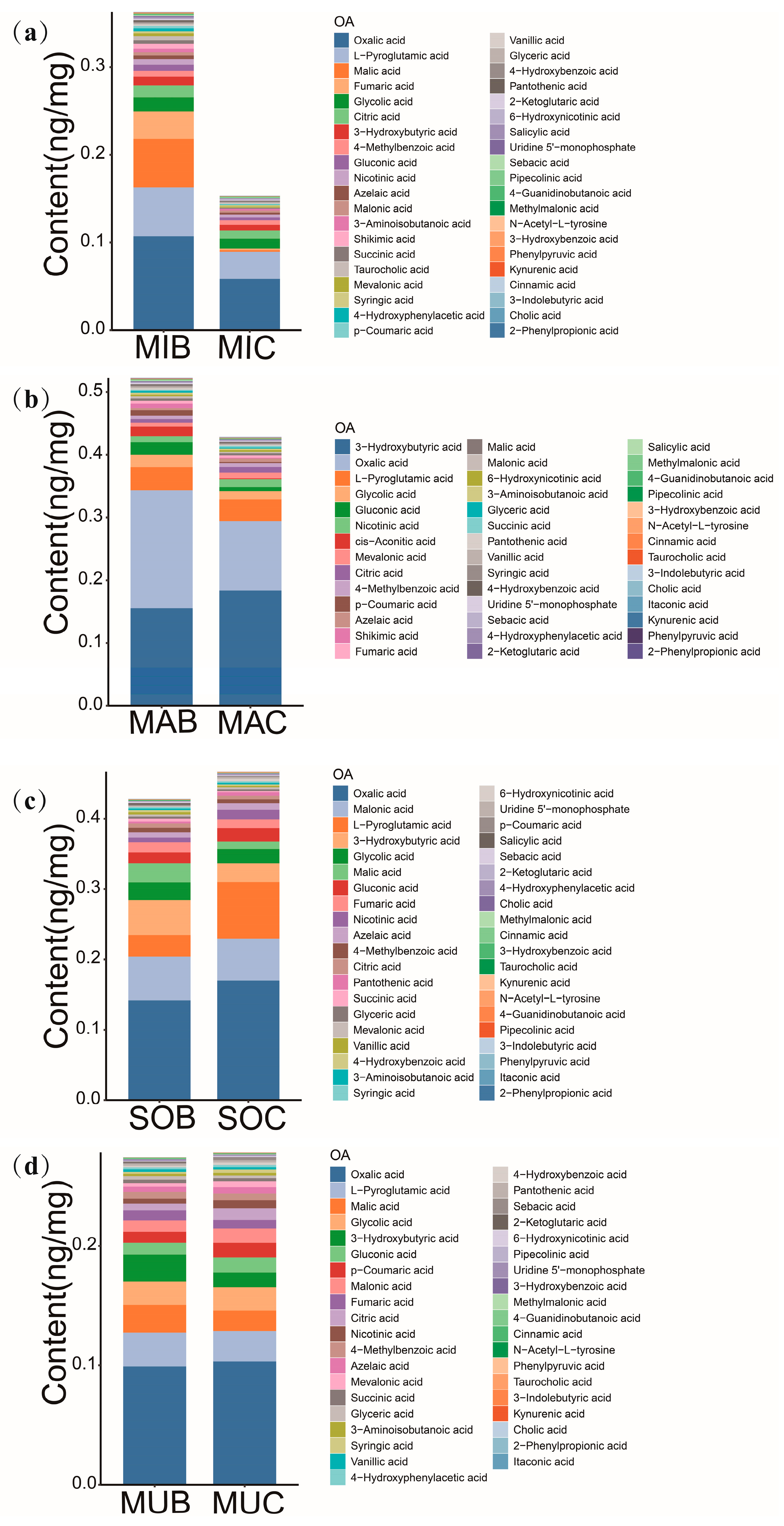
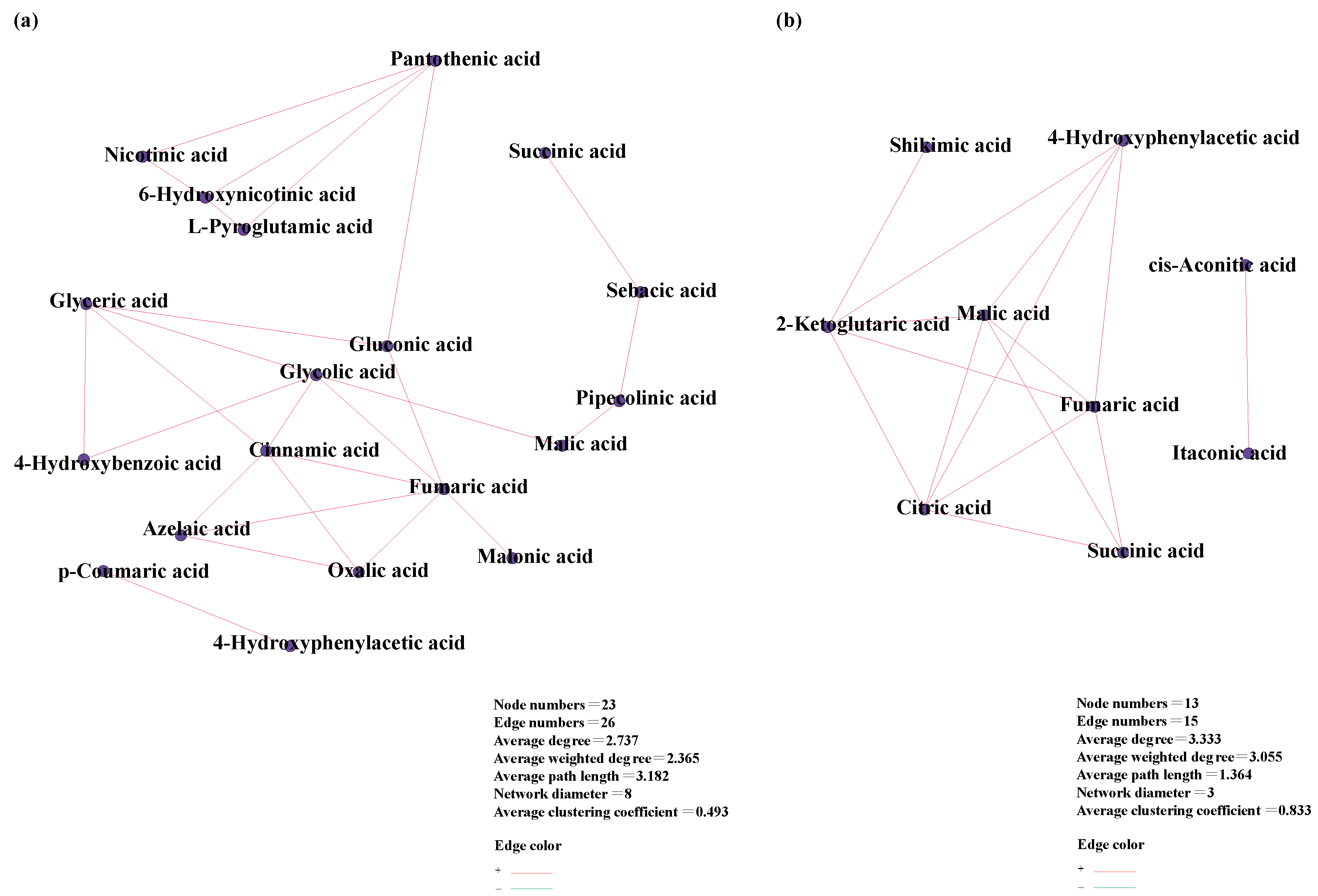
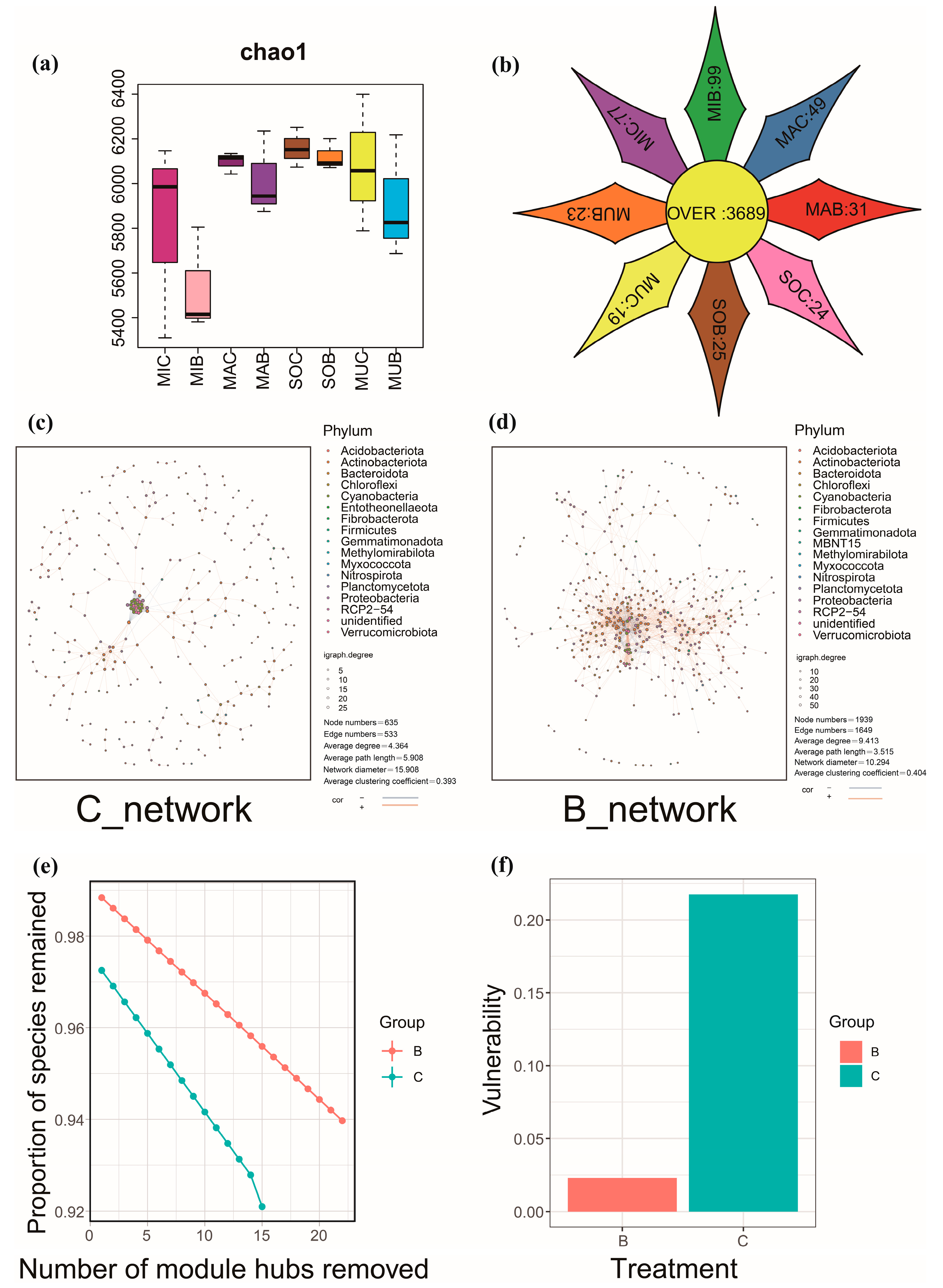
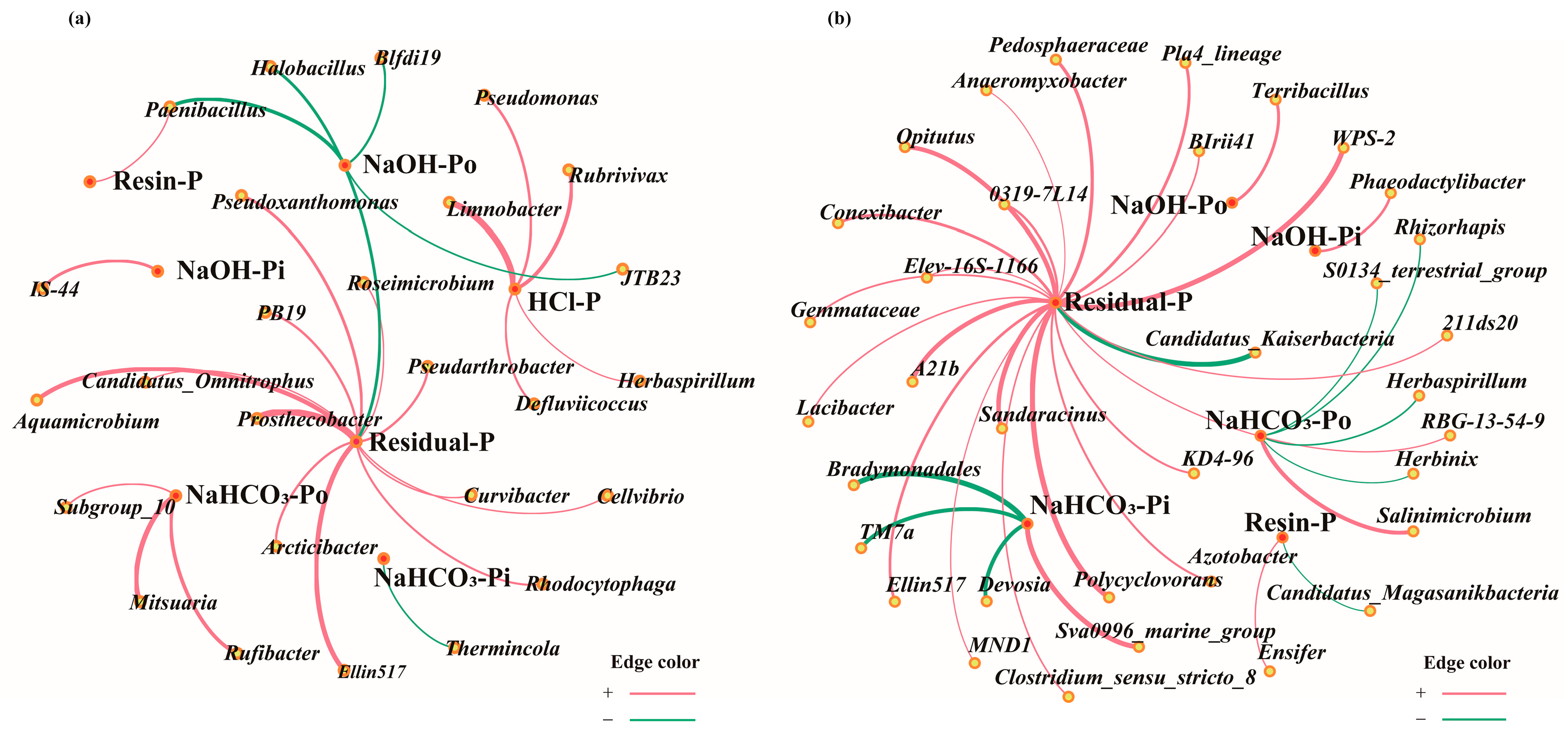
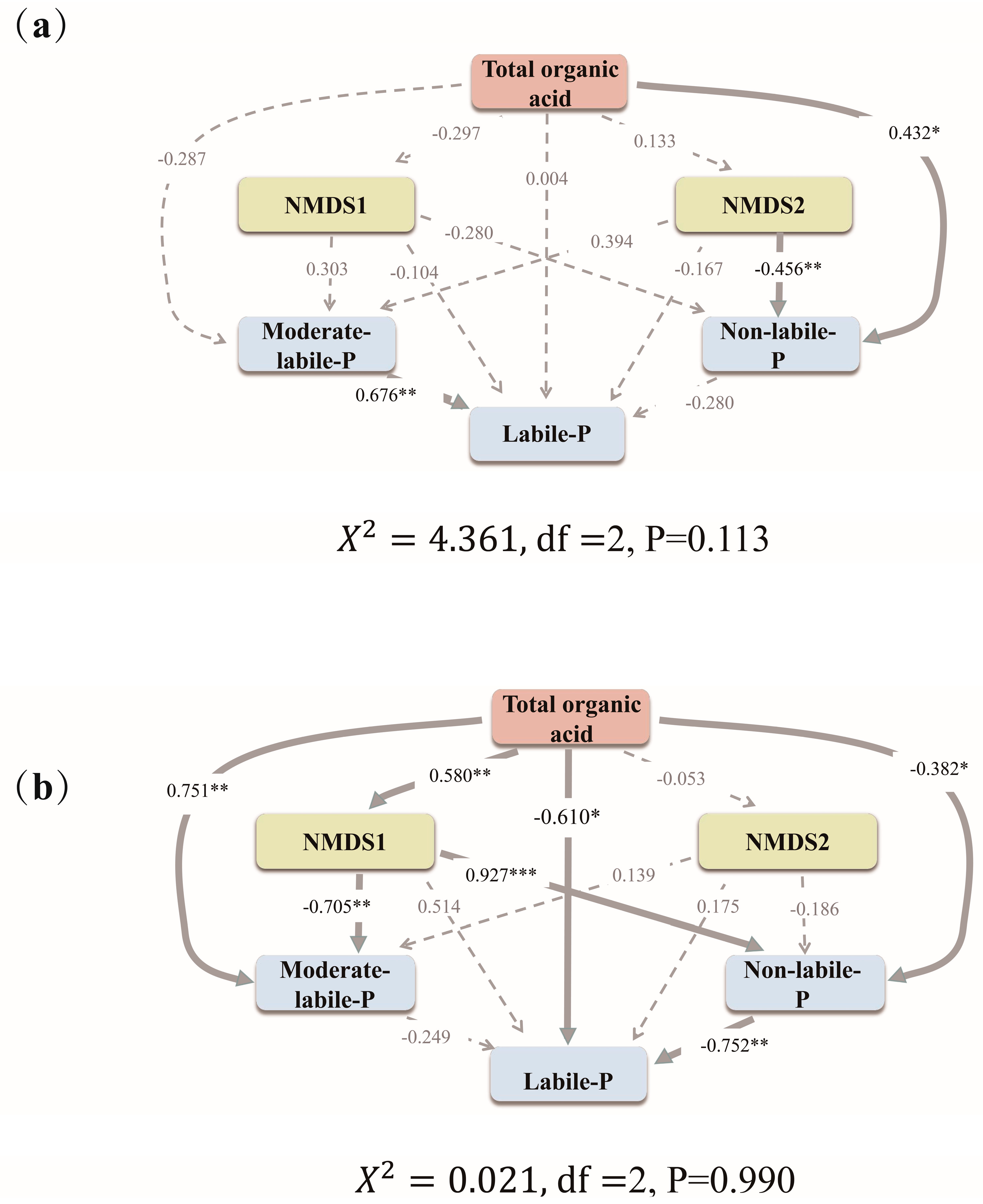
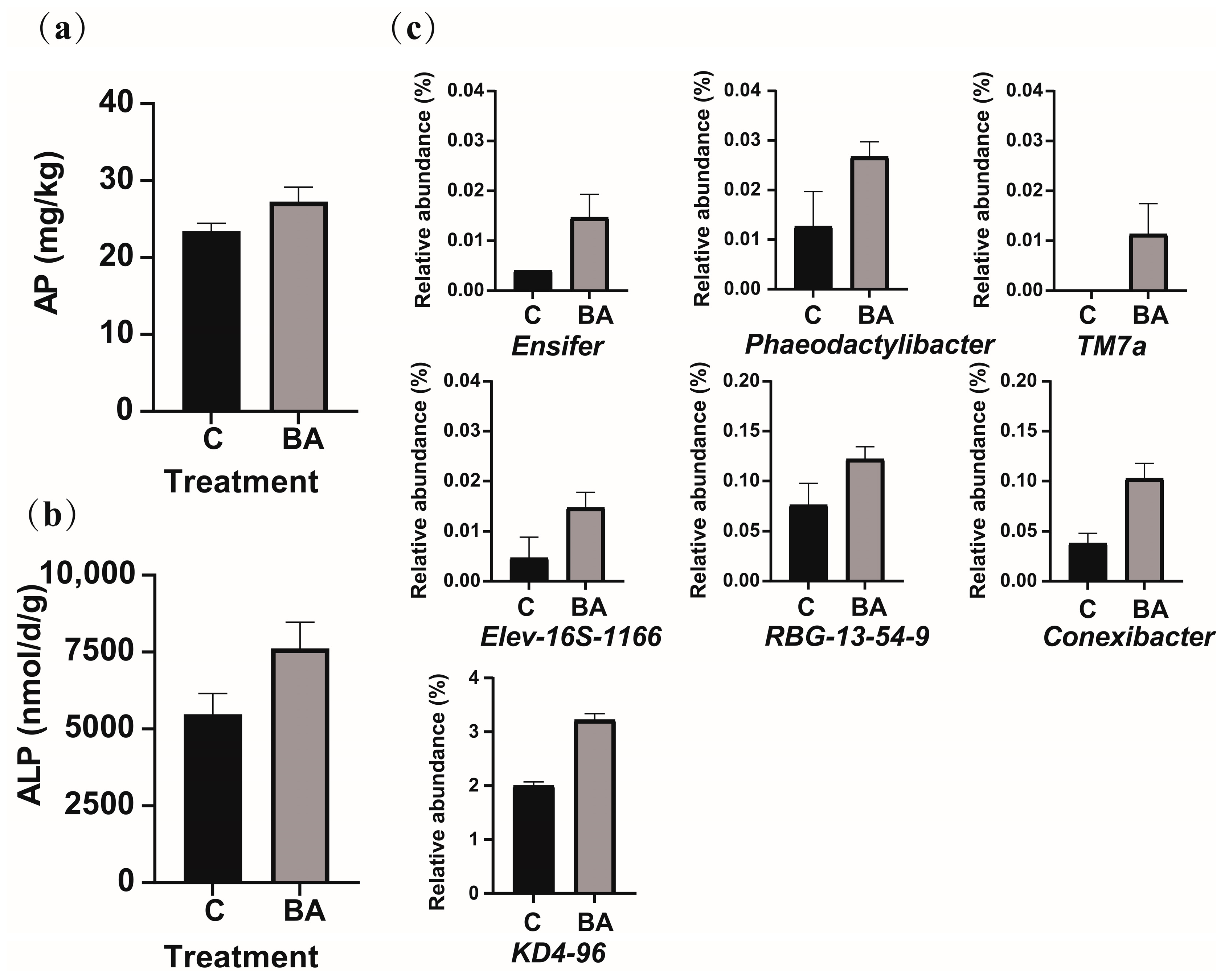
Disclaimer/Publisher’s Note: The statements, opinions and data contained in all publications are solely those of the individual author(s) and contributor(s) and not of MDPI and/or the editor(s). MDPI and/or the editor(s) disclaim responsibility for any injury to people or property resulting from any ideas, methods, instructions or products referred to in the content. |
© 2025 by the authors. Licensee MDPI, Basel, Switzerland. This article is an open access article distributed under the terms and conditions of the Creative Commons Attribution (CC BY) license (https://creativecommons.org/licenses/by/4.0/).
Share and Cite
Fan, B.; Zhao, L.; Yang, F.; Zhao, C.; Li, Z. Biochar Promotes Phosphorus Solubilization by Reconstructing Soil Organic Acid and Microorganism Networks. Agronomy 2025, 15, 1163. https://doi.org/10.3390/agronomy15051163
Fan B, Zhao L, Yang F, Zhao C, Li Z. Biochar Promotes Phosphorus Solubilization by Reconstructing Soil Organic Acid and Microorganism Networks. Agronomy. 2025; 15(5):1163. https://doi.org/10.3390/agronomy15051163
Chicago/Turabian StyleFan, Bowen, Liqin Zhao, Fengjun Yang, Changjiang Zhao, and Zuotong Li. 2025. "Biochar Promotes Phosphorus Solubilization by Reconstructing Soil Organic Acid and Microorganism Networks" Agronomy 15, no. 5: 1163. https://doi.org/10.3390/agronomy15051163
APA StyleFan, B., Zhao, L., Yang, F., Zhao, C., & Li, Z. (2025). Biochar Promotes Phosphorus Solubilization by Reconstructing Soil Organic Acid and Microorganism Networks. Agronomy, 15(5), 1163. https://doi.org/10.3390/agronomy15051163





